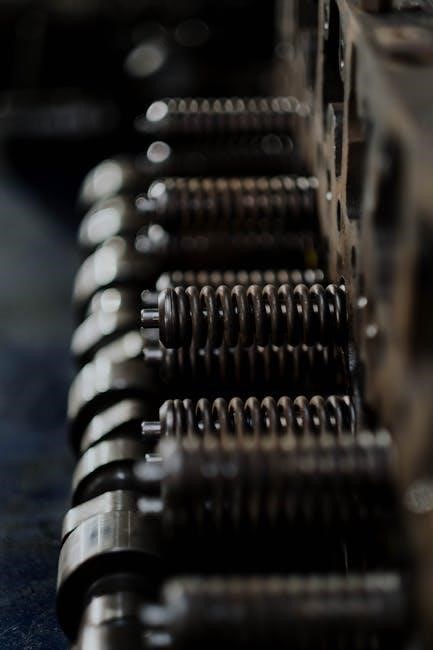The axles are the backbone of a Pinewood Derby car, connecting the wheels to the body and ensuring smooth motion. Made from small nails, they play a critical role in performance.
Overview of Pinewood Derby and Axle Importance
The Pinewood Derby is a popular racing event where participants, often Cub Scouts, craft small wooden cars with plastic wheels and metal axles. The axles, typically small nails, are essential for connecting the wheels to the car body. Properly installed and maintained axles ensure smooth movement, reduced friction, and optimal alignment, all of which are critical for achieving maximum speed and performance. The balance between weight distribution and axle efficiency is a key factor in determining a car’s success on the track.
Understanding Axle Materials and Quality
Pinewood Derby axles are typically made from small nails, but aftermarket options like stainless steel or polished axles offer improved performance, reduced friction, and better alignment.
Stock vs. Aftermarket Axles: Pros and Cons
Stock axles, included in Pinewood Derby kits, are simple and cost-effective but may have surface imperfections that increase friction. Aftermarket axles, made from materials like polished stainless steel, offer reduced friction and improved alignment but are more expensive. Stock axles are easy to use, while aftermarket options require more effort to install. Choosing between them depends on your goal: stock for simplicity and aftermarket for enhanced performance and speed.
Impact of Axle Material on Car Performance
Axle material significantly affects a Pinewood Derby car’s performance. High-quality materials, like polished stainless steel, reduce friction and wear, allowing the wheels to spin more freely. Lightweight alloys can improve speed by minimizing rotational mass. Conversely, stock nails may have rough surfaces, increasing friction and slowing the car. Upgrading to premium axles ensures smoother movement, better alignment, and faster times. The right material choice can be the difference between a mediocre and a winning car.
Preparation and Maintenance of Axles
Proper axle preparation involves polishing to reduce friction and aligning for optimal performance. Regular maintenance ensures smooth operation and extends lifespan, enhancing overall car speed and efficiency.
Polishing and Smoothing Axles for Reduced Friction
Polishing axles is crucial for minimizing friction, allowing wheels to spin freely. Start with coarse sandpaper, progressing to finer grits for a smooth finish. Use a mini file to remove ridges and imperfections, ensuring the axles glide effortlessly. Polishing reduces resistance, enabling faster speeds and better performance. Proper technique ensures a sleek surface, maximizing efficiency and helping the car reach its full potential on the track.
Aligning Axles Properly for Optimal Speed
Proper axle alignment is essential for maximizing speed and stability. Misaligned axles can cause friction and uneven wheel rotation, slowing the car. Use a Pro-Axle Guide to ensure accurate mounting in axle slots, improving alignment and reducing wobble. Straight axles allow wheels to spin freely and maintain consistent contact with the track, enhancing performance. Correct alignment ensures the car moves smoothly, optimizing its potential for a faster race time and better overall results.

Advanced Axle Modifications
Advanced axle modifications, like cheater axles, reduce friction and improve performance. These designs minimize surface contact with wheels, enhancing speed and stability for competitive racing.
Bent Axles: When and How to Use Them
Bent axles are used to improve alignment and reduce friction. They are ideal for cars that veer off track or experience uneven wheel contact. To bend axles, use a precise tool or vise to create a slight curve without weakening the metal. This modification ensures proper wheel alignment and smoother movement. Bent axles are particularly effective when combined with proper weight distribution, ensuring optimal speed and stability during races. However, over-bending can damage the axle, so caution is essential for the best results.
Cheater Axles: Design and Performance Benefits
Cheater axles are specially designed to reduce friction and improve performance. Unlike stock axles, they are polished or coated to minimize surface contact with the wheels, allowing smoother rotation. Their unique design enhances alignment, ensuring wheels spin freely and consistently. This results in faster speeds and better control during races. Cheater axles are a popular choice among experienced builders due to their ability to optimize performance without compromising durability. Proper installation and maintenance are key to maximizing their benefits.
Weight Placement and Distribution
Proper weight placement is crucial for maximizing speed and stability. Positioning the weight as far back as possible enhances momentum, but ensure balance to prevent wheel lift.
Optimal Weight Positioning for Maximum Speed
Placing weight as far back as possible, typically near the rear axle, maximizes momentum and speed. Use flat weights and ensure they are secure to avoid shifting during races. Positioning weight too far back can cause instability, so balance is key to maintain traction and prevent wheel lift. Proper alignment of axles and wheels is also essential for optimal performance. Tools like the Pro-Body Tool can help in chiseling and securing weights effectively, ensuring your car meets regulations and achieves maximum potential speed on the track.
Ensuring Proper Balance to Avoid Wheel Lift
Proper balance is crucial to prevent wheel lift, which can reduce stability and speed. Excessive weight near the rear axle may cause the front wheels to lift, especially during acceleration. To avoid this, distribute weight evenly, ensuring the car’s center of gravity is low and centered. Use tools like the Pro-Body Tool to precisely position weights and align axles. Ensuring balance enhances traction, maintaining all wheels on the track for optimal performance and control during races.

Wheel and Axle Compatibility
Wheel and axle compatibility is crucial for optimal performance. Stock axles work well, but aftermarket options offer improved alignment and reduced friction, enhancing overall speed and efficiency.
Choosing the Right Wheels for Your Axles
Choosing the right wheels for your axles is essential for performance. Stock wheels are compatible with most axles but may lack precision. Aftermarket wheels, often lighter and truer, enhance speed. Ensure the wheels are properly seated and aligned with the axles to minimize friction. Lighter wheels reduce overall weight, allowing for better weight distribution. Properly matching wheels to axles ensures smooth motion and optimal performance. Always check compatibility to avoid issues during assembly or racing.
Wheel Maintenance Tips for Better Performance
Proper wheel maintenance is crucial for optimal performance. Start by polishing the wheels with a fine-grit sandpaper or a small file to remove any imperfections. Ensure the wheels are free from debris and dust, as these can increase friction. Lightly lubricate the axle-wheel contact points with a dry lubricant like graphite powder. Avoid over-lubrication, as it may attract dust and reduce efficiency. Check for bent rims and straighten them if necessary. Finally, test the wheels on the axles to ensure smooth rotation and proper alignment before racing.

Step-by-Step Axle Installation Guide
Use the Pro-Body Tool to create pilot holes for axles. Insert axles using the Pro-Axle Guide for precise alignment. Ensure proper spacing and fit for optimal performance.
Tools and Techniques for Accurate Axle Mounting
Accurate axle mounting is essential for optimal performance. Use a Pro-Body Tool to create pilot holes for axles, ensuring proper alignment. The Pro-Axle Guide helps in precisely mounting axles within slots, reducing friction and preventing wheel lift. Align axles straight and parallel to the car’s body for smooth motion. Double-check spacing between axles and wheels to maintain even weight distribution. Proper tools and techniques ensure a sturdy, balanced setup, enhancing speed and stability for a winning Pinewood Derby car.
Common Mistakes to Avoid During Installation
When installing axles, avoid over-tightening, as it can cause friction and slow the car. Misaligned axles lead to poor tracking and reduced speed. Ensure axles are straight and parallel to the car’s body. Incorrect spacing between axles and wheels can cause wobbling. Avoid angled axles, as they disrupt balance. Using improper tools may damage axles or the car body. Finally, never skip testing the alignment and movement of wheels post-installation, as unseen issues can cost valuable time during the race.

Troubleshooting Common Axle Issues
Common axle problems include misalignment, excessive friction, and wear. Inspect axles for bends or debris and polish rough spots. Replace worn or damaged axles promptly.
Identifying and Fixing Misaligned Axles
Misaligned axles can significantly slow down your Pinewood Derby car. To identify misalignment, inspect the axle slots and ensure wheels roll straight. If the car drifts or wobbles, the axles may be misaligned. Use a Pro-Axle Guide to realign the slots accurately. For minor issues, carefully bend the axle back into place using needle-nose pliers. For severe misalignment, consider replacing the axle or re-drilling the slots. Proper alignment ensures smooth movement and maximum speed. Always test the car after adjustments to confirm the fix.
Solving Problems with Axle Friction and Wear
High friction and wear on axles can hinder your Pinewood Derby car’s performance. To address this, polish the axles using a fine-grit sandpaper or a mini file, removing any rough edges or burrs. Apply a light coat of graphite or silicone-based lubricant to reduce friction further. Regularly inspect axles for signs of wear and replace them if necessary. Smooth, well-maintained axles ensure optimal wheel rotation and faster speeds, giving your car a competitive edge on race day. Proper maintenance is key to minimizing friction-related issues.
Optimizing axles is key to a fast Pinewood Derby car. Polish, align, and maintain them properly for minimal friction and maximum speed; Good luck racing!
High-quality axles are essential for optimal performance. Polishing and aligning them reduces friction and ensures proper wheel contact. Use aftermarket axles for better precision. Maintain axles by smoothing rough edges and ensuring they are straight. Proper weight placement, close to the rear axle, enhances speed without causing wheel lift. Use tools like axle guides for accurate installation. Regularly inspect and clean axles to prevent debris buildup. Experiment with bent or cheater axles for advanced performance. Always test and refine your setup for the best results.
Additional Resources for Further Improvement
For further enhancement, explore online communities like DerbyNet and Maximum Velocity, offering detailed guides and tools. Check out feature articles and photo tours for inspiration. Utilize software like DerbyNet to analyze performance. Visit Cub Scout resources for official guidelines and tips. Watch video tutorials on axle polishing and alignment. Join forums to share ideas and learn from experts. Access Q&A sections for troubleshooting common issues. These resources provide comprehensive support to refine your Pinewood Derby axle setup and achieve optimal results.

